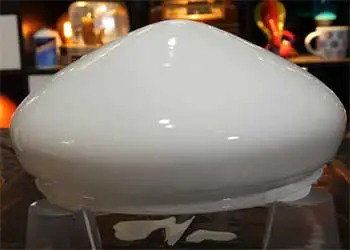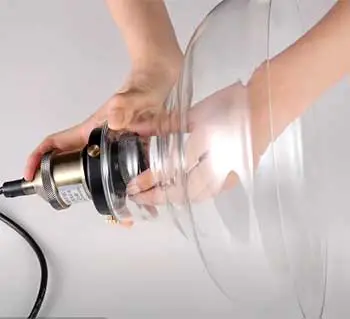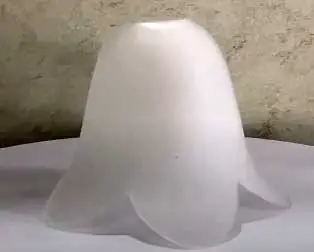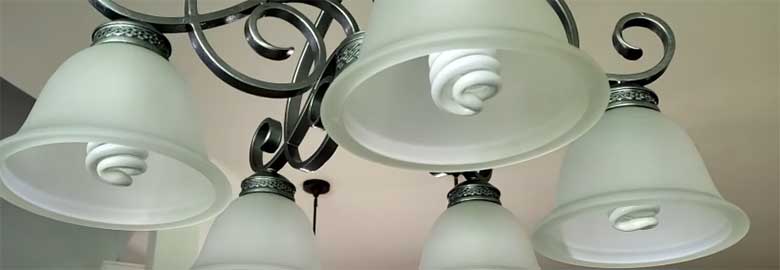Not all lighting fixtures will give you the same amount of light. They are different in shades, designs, and many other things. Have you been in a dilemma choosing between frosted glass and clear glass lighting fixtures?
Why should you select one over another?
These two blub fixtures don’t perform identically. They are made for specific purposes. After talking with a professional lighting designer, I gathered vital information about both lighting fixtures.
Read this post to have a better idea.
A Quick Comparison Table
Can’t wait to learn how Frosted Glass lighting fixtures are different from clear glass lighting? Here is a small table to get a quick idea about both types of fixtures.
| Specification | Frosted Glass Lighting Fixtures | Clear Glass Lighting Fixtures |
| Lights | Offer a lower amount of light | Offer a higher amount of light |
| Appearance | Good | Better |
| Softness/sharpness | Softer for eyes | Sharper for eyes |
| Lumens variations | Produce fewer lumens | Produce more lumens |
| Shade type | Chandelier, pendant fixture, or wall sconce | Metal shade or a cut paper shade |
| Ideal to use | Relaxing areas | Working areas |
| Customization | More customization of the lighting look | Less customization of the lighting look |
| Placement | Can be installed less close to the ceiling | Need to be installed closer to the ceiling |
| Price | Higher | Slightly lower |
In-depth Differences Between Frosted Glass And Clear Glass Lighting Fixtures
Is the table mentioned above enough for making a wise purchase decision? Maybe not! If you want to learn more precise details about both lighting fixtures, keep reading!
- Lights

The first important is considering the number of lights you are getting from a particular lighting fixture.
Even after using the same wattage lights on both lighting equipment, the outcome of the light will be different.
But don’t be confused. Both lights will produce the same lights.
But particular fixture plays the leading role in determining how much light will be reflected. Frosted glass lighting fixtures offer fewer amounts of lights by giving a blurry appearance.
In contrast, clear glass lighting fixtures offer as much light as much as the main bulb has. Hence, the more wattage your light has, the brighter clear glass lighting equipment can give.
- Appearance
Compared to frosted glass lighting fixtures, clear glass looks more appealing. If the bright glass lighting equipment has a more aesthetic design, it will add a richer appearance to your room.
However, frosted glass lighting fixtures block a significant amount of lights. So, you may not get as good a look as you expect, especially in public gathering rooms. They may look a little dull.
- Softness/Sharpness
Are your eyes more sensitive to lights? Do you struggle to look directly at bright lights? Frosted glass lighting fixtures will be softer and gentle on yes. You can glare more easily.
On the other hand, clear glass lighting fixtures might be a little sharp or harsh on your eyes if they are installed too close. You may struggle to glare continuously for long.
- Lumens Variations
The amount of light from a particular light is mainly measured by lumens. Higher lumen means brighter lights.
Frosted glass lighting fixtures will produce less lumen than clear glass.
However, our naked eyes may not notice without a proper test. For instance, a frosted light can produce 250 lumens from a 40W bulb.
In contrast, even after using the same light inside a clear glass light fixture, it will produce higher lumens (400-500).
- Shade Type

When choosing a particular light fixture, you must know its compatibility with various shades.
Otherwise, you won’t get your expected outcome.
If you have a chandelier, pendant, or wall sconce shade, choosing frosted glass lighting fixtures is the best.
They can create a timeless and enduring appearance in the installation area.
Contrastly, clear glass lighting fixtures are the best choice for a metal shade or a cut paper shade. They can provide a more uniform and attractive look.
- Ideal To Use
The place you are going to use is an important aspect to consider. Frosted glass lighting fixtures are generally great for bedrooms, dining rooms, drawing rooms, family rooms, etc.
On the contrary, clear glass lighting fixtures are mainly suitable for working areas where you need more lights. You can also use them for kitchens and bathrooms
- Customization
Do you only use bulbs just for getting lights? If you are a fashion-conscious person, you may want to make your lighting more attractive.
Frosted glass lighting fixtures are suitable for more customization. They can direct lights in ways and patterns. You will like the distinctive shadows it makes to adore your room beautifully.
Though clear glass lighting fixtures are also available in a lot of customization options, they are not as much as frosted blubs.
- Placement
We generally install bulb fixtures on the ceilings. Keeping a particular distance is important depending upon the ceiling height.
You can install frosted glass lighting fixtures less closely to the ceiling area. Since frosted bulbs don’t offer too much light, they will be gentle even after installing them in a closed area.
However, installing glass lighting fixtures closer to the ceiling area is good if the light brightness is too intense. Otherwise, you will struggle to glare.
- Price
There are almost no differences between frosted and clear glass lighting fixtures. Price may vary depending upon type, brand, construction quality, and many other things.
However, frosted glass lighting equipment has more preciseness to dissolve a particular amount of lights. This makes them slightly pricier than clear glass options.
Pros and Cons of Frosted Glass Lighting Fixtures
Here are some of the major upsides and potential downsides of installing frosted glass lighting fixtures:
Benefits of Frosted Glass Light Fixtures

- Soft, Diffuse Lighting – The translucent glass subtly scatters the light in all directions, filling a space with soft, glowy illumination. This makes frosted glass a great choice for ambient lighting.
- Conceals Interior Elements – The obscuring quality of frosted glass prevents clear views of the inner wires, bulbs, hardware or any imperfections in the light fixture, allowing for a clean, uniform look.
- Increased Privacy – Bathroom vanity lights, pendant fixtures and other transparency risks gain privacy when fitted with opaque frosted glass. This prevents views through the light from adjoining rooms or outside windows in many cases.
- Variety of Textured Glass Options – While classic milk white frosted glass is most common, textured glass comes in numerous styles. This includes seeded, floral, cracked ice and more unique looks to complement your decor.
- Easier on the Eyes – Softer lighting tends to be less harsh and glaring. This makes fixtures fitted with translucent glass panels gentler for eyes over long periods, especially important for task lighting areas.
- Subdued Style – The understated, diffuse glow of frosted glass fixtures blends into a space for a subtle decorative accent. This versatility pairs well with most color palettes and decor styles from modern to traditional.
Potential Downsides of Frosted Fixtures
- Less Bright Light – The diffusing effect of frosted glass can significantly reduce light transmission. This isn’t ideal for spaces like kitchens or workrooms where abundant, well-lit spaces are key. Boosting wattage can help compensate when needed.
- Hides Beautiful Bulbs – The filament and other intriguing elements of bare bulbs don’t stand out behind opaque glass. Consider clear glass to showcase distinctive light bulbs like Edison-style filament LEDs.
- Prone to Showing Smudges and Grime – Oil, dust and dirt often appear as unsightly smudges much more obviously on matte finishes like frosted glass. Frequent cleaning is key for light fixtures to retain their beauty over time.
- Fewer Dramatic Shadows – Subtler shadows behind furnishings and architectural elements can minimize striking chiaroscuro visual effects. Combine with directional lighting like recessed cans to balance soft and sharp light.
- Not as Crisp – While some enjoy the softness, others may find thicker frosted glass diffuses things too much, coming across as a bit hazy. Thinner frosted panels retain more clarity while still obscuring effectively.
Pros and Cons of Clear Glass Lighting
Now let’s explore the major advantages and possible issues with installing clear glass lighting fixtures:
Upsides to Clear Glass Light Fixtures
- No Diffusion, Maximum Light – Unlike translucent panels that scatter illumination, transparent clear glass enables virtually all light to permeate uninhibited. This allows bright, directed rays perfect for task lighting needs.
- Showcases Bulbs and Interior – Clear panels give unobstructed views of intricate bulb styles, sleek hardware and interior elements. Make a design statement with eye-catching filament or vintage Edison-style LEDs.
- Crisp and Sharp Style – Avoiding diffusion allows clear glass fixtures to cast bold shadows and architectural accent lighting effects. The see-through clarity also feels crisp rather than hazy.
- Easier to Keep Clean – Without a speckled surface or texture to collect dust and oils, smooth clear glass generally requires less frequent cleansing to retain its see-through beauty and shine.
- Good for Showers and Wet Locations – Humidity can exacerbate frosting on glass over time. Clear panels avoid this, making them a better choice for steamy bathrooms and covered outdoor installations prone to moisture.
- More Design and Bulb Options – From crystal cut to colored and patterned, clear glass accommodates greater variety in aesthetics. Compatibility with most bulb types, including smart color-changing, also allows more versatility.
Potential Cons of Clear Glass Fixtures
- Exposes Unsightly Interior Elements – Rather than conceal, transparency spotlight wires, hardware, brackets and any flaws or dirt inside the fixture. Meticulous cleaning and upkeep is imperative for attractive see-through lighting.
- Glare Issues – Without diffusion, intense light shining directly from bulbs can cause eye strain and discomfort over time, especially for task lighting. Consider lower lumen output, positioned task lighting or lamp shades.
- Less Soothing Ambient Light – For general lighting goals like living rooms, bedrooms and dining spaces, visible bulbs and harsh rays don’t provide the most inviting cozy atmosphere. Diffusers can help soften clear glass fixtures when desired.
- Reduced Privacy – Bathrooms, bedrooms and other personal spaces lose obscurity with transparent light panels. Opaque backing paint or films provide privacy when needed on clear fixtures.
- Showcases Flaws in Surrounding Space – The clarity of transparent glass fixtures also enables clear views of any imperfections in your space. This includes water spots, outdated tile, uneven paint and unflattering room perspectives.
- Prone to Glare and Reflections – Sun pouring in from windows can reflect intensely off smooth clear glass, causing frustrating glare issues indoors. Consider positioning or the addition of lamp shades if this occurs.
Which Lighting Fixture Will Be The Best For Your Home?

Since our requirements vary, not all will choose the same lighting fixtures. It generally depends on how much light you prefer.
Clear glass lighting fixtures are the best choice if you want brighter lights from your bulbs.
On the other hand, a frosted lighting fixture appears a good pick when you are okay with a slightly reduced amount of lights. However, you can use both of them in different rooms of your house.
Frequently Asked Questions (FAQs)
No, dissimilarities exist between light bulbs and frosted bulbs except for the internal surface of the globe.
Quartz-fused silica glass, tempered soda-lime glass, borosilicate, etc., are the most commonly used glasses for light fixtures.
Frosted LED bulbs have a blurry cover to block a small portion of lights with its opaque finish. In contrast, clear LED bulbs feature a crystal-clear surface that allows you to see the bulb.
Yes, you can frost a clear light bulb. But the lights coming from the bulb won’t be as realistic as a newly made frosted light bulb.
Final Words
So, you have already learned a lot of precise details on frosted glass vs. clear glass lighting fixtures. Both lighting equipment are suitable for a particular objective.
You must first know what benefits you will get for installing a specific lighting fixture.
However, many household owners install both types of lighting equipment in their homes since you can use the same light for each. Hopefully, you can now decide which is the best option for your house to use.

My wife is looking at typical above the vanity/sink bathroom light fixtures. She would like the most amount of light in the sink area for applying make-up. Does a three bulb fixture (of down aiming shades) provide better light at the mirror above this sink if it has clear glass shades or will it provide more light with frosted glass shades? The ceiling is white metal and is 9′ high. We plan on placing this light fixture a standard height above the sink. Thank you for your expert advice.